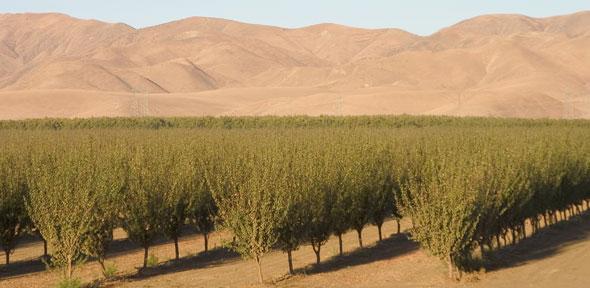
In 2013, almond yield from one of Olam’s mature orchards in California declined by 15 per cent, prompting an enquiry into how efficiently these almond trees utilise water. Maintaining the flow of water, with a pH of 6.5, at a well-timed interval is essential to maximise almond yields, thereby highlighting the importance of both water availability and quality.
 In 2014, the orchard only received 49 per cent of normal precipitation levels and it is extremely likely that the drought will continue through 2015. Given the lack of precipitation and lack of available surface water, the orchard relies entirely on a groundwater pumping system to irrigate the almond trees. However, this can be insufficient: in 2014, groundwater pumping capacity decreased to 5,500 gallons per minute and the orchard fell short of its water demand.
In 2014, the orchard only received 49 per cent of normal precipitation levels and it is extremely likely that the drought will continue through 2015. Given the lack of precipitation and lack of available surface water, the orchard relies entirely on a groundwater pumping system to irrigate the almond trees. However, this can be insufficient: in 2014, groundwater pumping capacity decreased to 5,500 gallons per minute and the orchard fell short of its water demand.
In addition to quantity, groundwater quality is a challenge as pH is often higher than that required for almond tree growth and can therefore affect the soil’s health and water infiltration rates. The increased application of groundwater has also caused soil sodium levels to increase, and has subsequently impaired water infiltration and nutrient uptake by tree roots.
The variability of water quality and quantity impacts soil and plant health and subsequently affects both short-term and long-term yield potential for almonds. To deal with such challenges, Olam formed a collaborative team to develop a drought response action plan which included: more efficient and timely irrigation to build soil moisture profile; increased efficiency of existing wells by cleaning perforations; application of compost, organic acids and soluable calcium; acidification of the water to reduce the bicarbonate salts and lower the pH to 6.5 and a pipeline installation to flexibly transfer water to different parts of the orchard.
Enhancing the water-holding capacity and nutrition of soil has allowed Olam to turn away from its dependency on an ever more pressured water resource. Olam’s work proved that there are in fact more cost-effective solutions to the drought issue than the long term and costly process of deepening wells or treating poor- quality water and these involve a broader look at soil dynamics.



